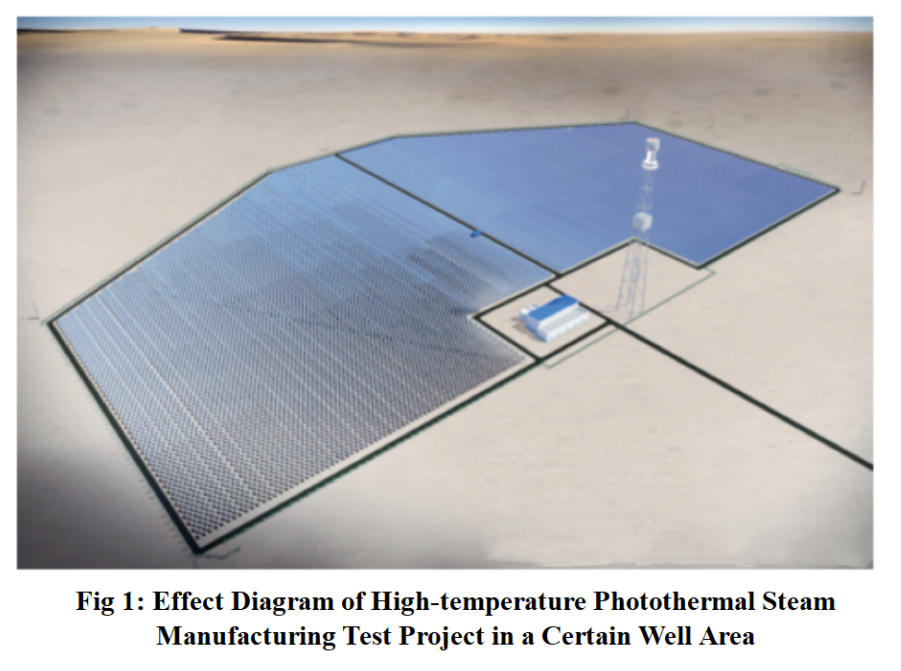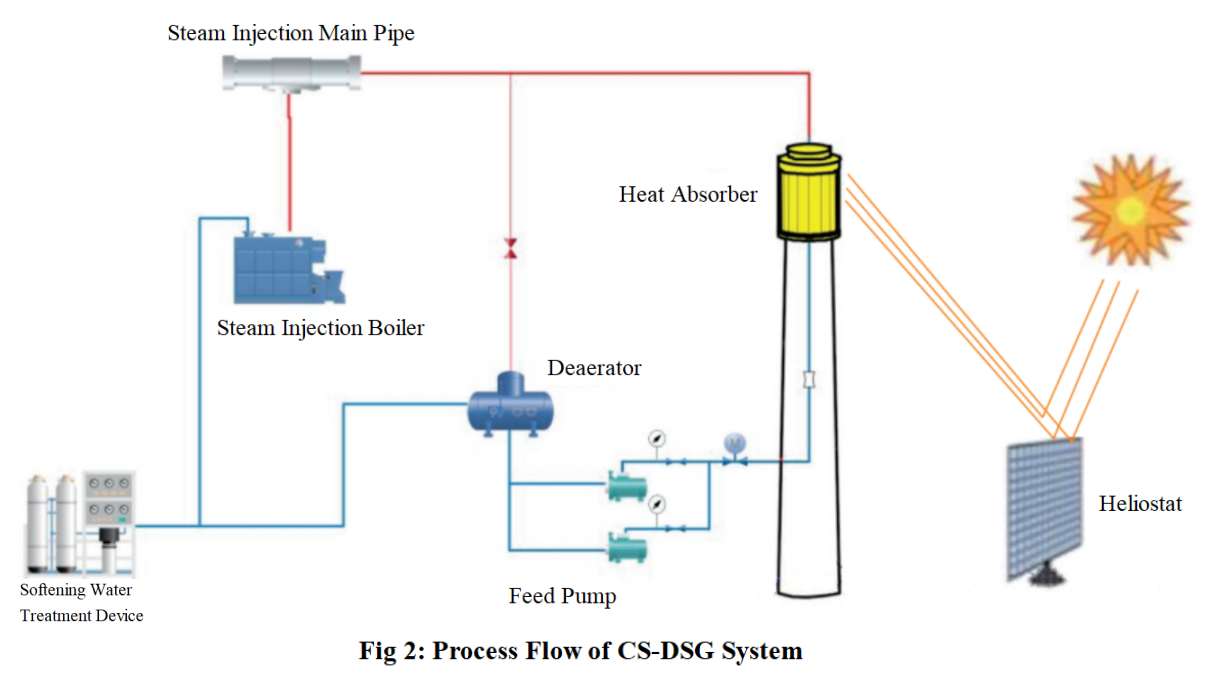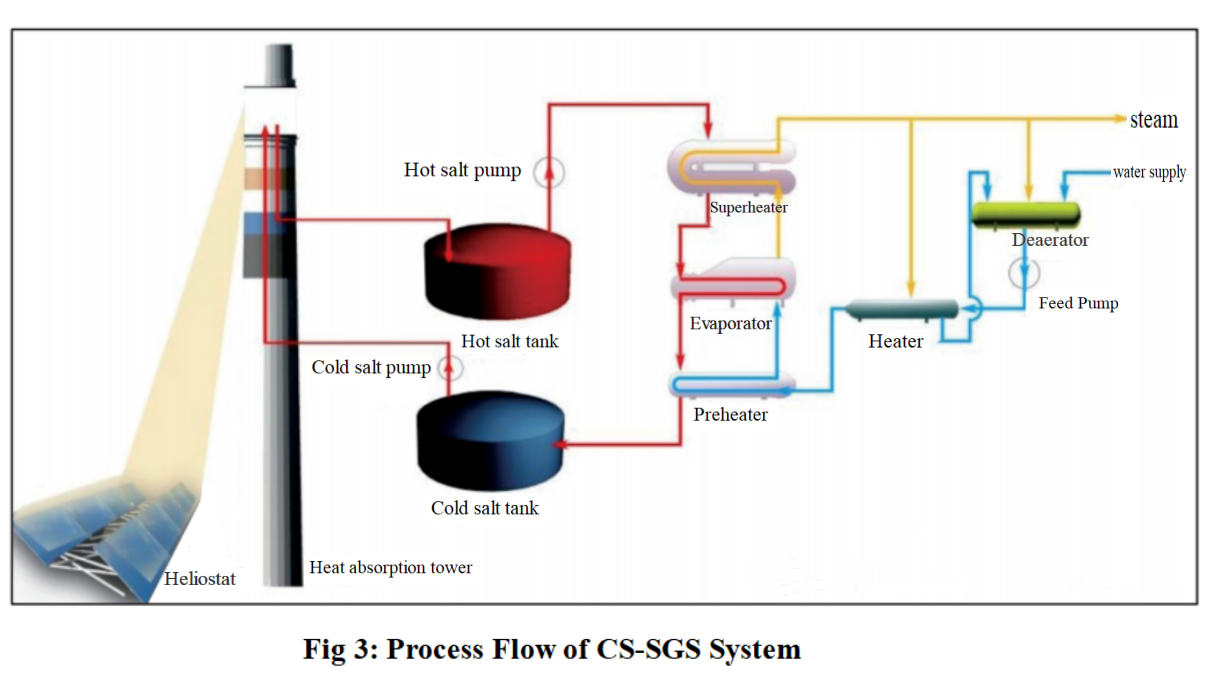Solar High-temperature Photothermal Technology Empowers Low-carbon Development of Shallow Ultra Heavy Oil (Part 1)
Abstract
Xinjiang Oilfield Company recently conducted a pilot test of coupling high-temperature photothermal steam production with steam injection boilers in a certain well area, providing low-carbon and high-quality steam for the development of heavy oil steam assisted gravity drainage (SAGD). The implementation of pilot experiments has a pioneering demonstration significance for the integration of oil and gas exploration and development with new energy technologies. Under the "dual carbon" goal, Xinjiang Oilfield Company faces the challenge of reducing natural gas consumption and carbon dioxide emissions in heavy oil production. Propose new energy supply configuration schemes for the steam injection process in shallow heavy oil extraction in different scenarios, combining solar focused heating technology, green electricity+electrode molten salt heating technology, and high-temperature heat storage technology. This provides specific ideas and solutions for the large-scale application of solar high-temperature photothermal technology in heavy oil operation areas of Xinjiang oil fields. It reduces the cost of steam as much as possible while reducing self use of natural gas, and has important guiding significance for low-carbon and sustainable development of heavy oil fields.
The Junggar Basin in Xinjiang is rich in oil and natural gas resources. The northwest edge of the basin is a shallow super heavy oil enrichment zone, characterized by shallow burial depth, small dissolved gas volume, weak natural driving energy, and high viscosity. Injecting high-temperature and high-pressure steam into heavy oil reservoirs to reduce viscosity and increase fluidity is an effective method for developing shallow ultra heavy oil. At present, steam is mainly produced by burning fossil fuels such as coal and natural gas, with high energy consumption. According to statistics, the energy consumption of the steam injection system accounts for approximately 98.6% of the total energy consumption in heavy oil production.
The National Energy Administration recently proposed that oil and gas exploration and development should be integrated with new energy development, and called for increased technological innovation and research efforts in the integration of oil and gas exploration and development with new energy. The Xinjiang Uyghur Autonomous Region also vigorously advocates green production, especially accelerating the low-carbon transformation of the three key industries of coal, petroleum, and chemical industry. Therefore, by fully utilizing the abundant solar energy resources in Xinjiang region and using concentrated solar energy and heat storage technology, clean heating can be achieved in the oil and gas production process, assisting in low-carbon oil and gas development.
1. Overview of Solar High-temperature Photothermal Steam Production Technology
The solar focused heating technology is mainly applied in the field of solar thermal power generation. Both the United States and Oman have carried out solar thermal steam production demonstration projects in heavy oil steam recovery. In 2010, Oman completed the Miraah 7 MW demonstration plant (23ºN), using a closed trough solar thermal system with a daily steam production of 50 tons; Chevron Corporation of the United States has built a 29 MW solar thermal steam demonstration facility in Corinna, California (36ºN), using tower heating technology. The operation has been effective from 2011 to 2014. Xinjiang Oilfield Company is conducting a pilot test project for high-temperature photothermal coupled steam injection boiler combined steam supply in a certain well area. The well area is located at 46ºnorth latitude, with an annual sunshine duration of 2637 hours. The average normal direct solar radiation (DNI) over the years is 1360 kW·h/m2, and the distribution of light resources is uneven in winter and summer. Therefore, a tower style photothermal technology route with high concentration ratio is selected. Adopting a north mirror field layout to improve the cosine efficiency of the mirror field, softened water is used as the heat collecting medium to directly generate steam in the heat absorber. Adopting a coupled operation mode with the steam injection boiler, without setting up ground heat storage facilities, using the underground steam chamber formed by the SAGD oil extraction process as a buffer to mitigate the impact of changes in light resources on steam volume fluctuations. The project effect diagram is shown in Figure 1.

The high temperature photothermal direct steam generation (CS-DSG) system configured for the project can be divided into concentrated solar collection system, water working medium heat absorber (steam generation system), steam water system, and electrical and thermal control system. The concentrated heat collection system collects solar energy, reflects sunlight, and focuses it on the heat absorber. It uses solar radiation heat to heat the water working fluid inside the heat absorber, and the feedwater enters the evaporation section, steam drum, and superheater of the heat absorber to form high-quality superheated steam. The process flow of CS-DSG system is shown in Figure 2.

When the steam output is affected, adding a high-temperature molten salt heat storage system and configuring a steam generator can mitigate the steam output impact caused by fluctuations in light resources. The process flow of the high-temperature photothermal continuous steam generation (CS-SGS) system with a heat storage device is shown in Figure 3.
The CS-SGS system has added a heat storage device, using molten salt as the heat absorbing and storage medium. It adopts a dual tank heat storage method of cold and hot salt tanks, and is equipped with a molten salt steam generation system. The heated molten salt enters the steam generator from the hot salt tank for heat exchange with the water working medium, heating the feedwater into superheated steam. The heated molten salt returns to the cold salt tank and is pumped into the heat absorption tower to absorb solar energy. The solar energy is stored in the hot salt in a sensible manner.

The high-temperature molten salt thermal storage technology has been applied in the solar thermal power generation industry for decades and is currently the mainstream high-temperature thermal storage technology. Molten salt generally has good thermal stability, high latent heat value, and low vapor pressure. Compared with thermal storage media such as thermal oil and liquid metal, it is cheaper and has abundant reserves. In the solar thermal power generation molten salt system, the most commonly used is nitro type binary molten salt, namely the sun (60% NaNO3+40% KNO3), with a melting point of 220℃ and a decomposition temperature of 575℃; The commonly used molten salt in the chemical industry is the ternary nitro salt, namely HITEC salt (7% NaNO3+53% KNO3+40% NaNO2), with a melting point of 142℃ and a decomposition temperature of 450℃. Although solar energy gathering technology and high-temperature molten salt thermal storage technology are mature, the unit investment is relatively high, and due to the influence of local light resources, there is still a problem of poor economic efficiency in replacing natural gas to produce steam in Xinjiang oil fields. Taking the photothermal pilot test project in a certain well area of Xinjiang Oilfield as an example, the steam cost calculated by adding a molten salt thermal storage system is 100 yuan/t higher than that of a photothermal direct steam production system without a thermal storage system. Considering the impact of cloudy and rainy weather, to achieve continuous energy supply, it is necessary to further increase the scale of heat storage.
The northern region of Xinjiang is rich in wind and solar renewable energy. Xinjiang Oilfield Company is currently carrying out the construction of new energy generation facilities mainly based on wind and photovoltaic power. It may consider converting the produced green electricity into thermal energy and storing it in the molten salt system. On the basis of solar concentrated heat collection and molten salt heat storage system, a molten salt electric heating furnace is added, which utilizes daytime wind and solar power curtailment and nighttime valley electricity to heat molten salt. The capacity of the heat storage system is reasonably utilized, and the energy storage scale is improved. While reducing the cost of steam supply, it also reduces the curtailment of wind and solar new energy sources around the oil region.
Electric heating furnaces can be divided into different types based on heating principles, such as resistance type, electromagnetic type, and electrode type. The resistance heating method adopts low voltage input and is suitable for single electric heating furnaces with small power (<3 MW). During the heating process of molten salt, the local high temperature formed on the surface of the electric heating tube can cause salt decomposition denaturation and local heat transfer deterioration. The electromagnetic heating method has the problem of reduced power and overall energy conversion efficiency during the process of electric to magnetic to heat conversion. Generally, the comprehensive efficiency of electromagnetic heating is less than 90%. The heating method of molten salt electrodes can effectively solve the problems of resistance and electromagnetic technologies in high-capacity molten salt heating. Molten salt itself is a resistor, and there will be no uneven heating or local overheating; The electrode heating efficiency can reach over 99%, and the input high voltage can increase the power of a single unit, making it suitable for large-scale electric heating.
The Blue Book of China's Solar Thermal Power Industry in 2022 points out that reducing the cost of concentrators and improving the efficiency of concentrator fields have always been a major issue in promoting solar thermal power generation. The levelized cost per kilowatt hour (LCOE) of global solar thermal power generation has decreased from 0.358 US dollars/(kW·h) in 2010 to 0.114 US dollars/(kW·h) in 2020, a 70% decrease over the past decade. The report predicts that by 2030, the cost of tower solar thermal power plants on solar islands will decrease by 23.1%, with an average annual cost reduction rate of 3%. The processes of focusing, absorbing heat, and thermal power conversion are the main components of energy and efficiency loss in the system, accounting for approximately 97% of the total loss. Therefore, the key to improving the efficiency of solar thermal power generation lies in improving the efficiency of heat collection and thermal power conversion processes. According to conservative estimates, by 2030, the photothermal conversion efficiency of concentrated solar systems can be improved by 14%, with an average annual growth rate of 1.9%. This is specifically reflected in the technological improvements and system optimizations of heliostat cleaning technology, cloud prediction technology, heliostat mirror surface process, mirror field layout process, truncation efficiency optimization, and heat absorber coating. Benefiting from the improvement of high-temperature photothermal technology and the decrease in costs in the future, the application of high-temperature photothermal in heavy oil thermal recovery has broad development prospects.
Based on the production scale and future development plan of Xinjiang Oilfield Company for heavy oil, relying on local renewable energy endowment and project boundary conditions constraints, this article proposes solar thermal heating solutions for three different heavy oil extraction scenarios. On the basis of ensuring energy supply and steam quality, a comparative analysis of the solutions is carried out with the goal of minimizing steam cost.
2. Photothermal Discontinuous Steam Production Solution
The thermal recovery process of heavy oil mainly includes steam huff and puff, steam flooding, SAGD, and combined flooding and drainage (VHSD) methods. Its basic principle is to inject high dryness or superheated steam into the oil layer to heat the oil layer, thereby reducing the viscosity of heavy oil and increasing its fluidity, in order to facilitate oil recovery lifting and transportation.
During the SAGD extraction process, the reservoir is mainly heated by the latent heat of vaporization of wet saturated steam, and the heat transfer to the crude oil is mainly through heat conduction, supplemented by convection. At a certain stage of development, the underground steam chamber formed after oil drainage expands horizontally, and the adjacent well to well steam chambers are connected. The steam chamber formed by underground development has good thermal storage conditions. Experiments have found that when using variable flow steam injection, the final recovery rate, breakthrough time, peak oil production period, and continuous stable steam injection have almost the same production effect.
